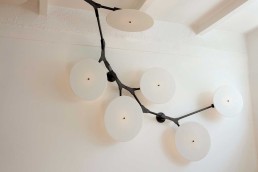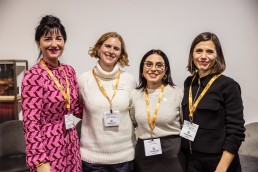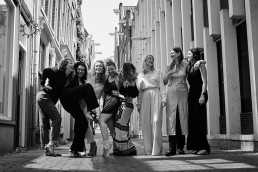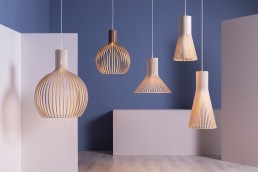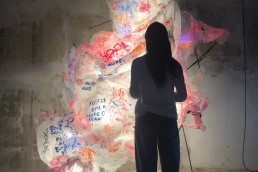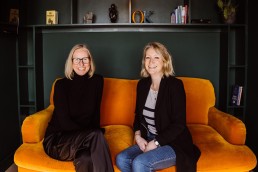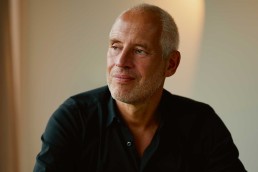Lindsey Adelman - Branching Disc Collection new variations
(USA) – New York-based lighting design company has extended its Branching Disc Collection with new variations.
Originally featuring delicate ceramic discs crafted in Munich by Nymphenburg Porcelain, the collection now includes options in hammered bronze, hand-spun domes, and natural earthenware. These new materials provide expanded customisation possibilities, allowing designers to tailor the minimalist lighting system to diverse aesthetics. The collection emphasises a balance of craftsmanship and adaptability, for a wide range of architectural and design concepts.
Women's Industry Groups: Who are they and why do we need them?
As a part of the lead up to International Women’s Day this Saturday we at darc want to reiterate some of the women in design industry groups we work alongside, discuss the impact they’re making and why joining or supporting such groups are important to everyone.
Women’s industry networking groups are crucial for providing a supportive space to address gender-specific challenges, promote mentorship, and foster career growth. In many industries, particularly those dominated by men, which is most, women face barriers such as pay gaps, lack of representation in leadership, and limited mentorship opportunities.
Industry networks for women help break the cycle of work inequality by connecting them with role models, providing guidance, and encouraging career advancement. Additionally, they create a safe environment to discuss workplace issues, such as gender bias and work-life balance, without judgment. While some criticise these groups for being exclusionary, advocates argue that they are necessary to drive meaningful change, increase diversity in leadership, and inspire future generations of women in the workforce.
Women in Lighting (WIL)…
WIL is a global digital platform dedicated to showcasing and celebrating women in the lighting and lighting design industry. Through storytelling, social activism, and a strong online presence, WIL highlights achievements, challenges unconscious bias, and inspires the next generation. Supported by ambassadors in 75+ countries, the initiative fosters a connected international community, offering resources, local and global initiatives, an annual conference on 8 March, and an awards programme to recognise excellence in the field.
Established in 2019, by Martin Lupton and Sharon Stammers, the duo, known as Light Collective, are committed to documenting and celebrating all things light and all that it empowers. The Women in Lighting organisation has documented essential research into gender imbalances in the industry including a global survey in 2023 examining the lighting profession’s equity and opening discussions on how to change this.
Women in Office Design (WOD)…
Another close collaborator with [d]arc media, WOD is a global platform for female architects and designers to collaborate, connect and create. The groups goals are dedicated to promoting professional growth, leadership and connecting other design individuals with the goal of empowering women in their professional roles.
Founded by interior designer Harsha Kotak in May 2018, Kotak noticed the disparity in numbers of women executives in the workplace design industry and these statistics were surprising, if not disconcerting. She poses the question at many event gatherings; what do we want our industry to look like and how do we get there?
Women in Architecture (WIA)…
A dedicated group of women from diverse backgrounds working to promote equity and inclusion in architecture. Led by a committed steering group and supported by a wider committee, ambassadors, and industry collaborators, WIA drives initiatives such as mentoring and networking events.
Reformed in 2018 following the documentary ‘She Draws: She Builds’, WIA gained momentum alongside the #MeToo movement, expanding its outreach and advocacy. Today, it continues to champion female architects through events, mentorship, and community-building efforts across the UK and beyond. Through community-building, policy advocacy, mentorship, and collaboration, WIA aims to create a more inclusive profession. In 2024, its focus includes expanding networks, shifting work culture, and strengthening mentorship. WIA remains committed to evolving its mission to meet the challenges of the profession.
Women in Furniture Network (WFN)…
A networking group curated for women in the furniture industry to learn, connect, and share their ideas. Created in conjunction with ‘The Furniture Show’, the platform was created with the belief that whatever position you hold in the furniture industry women should be offered a supportive space to thrive and grow professionally.
WFN offers a mentorship programme where people in the furniture industry can connect with mentors who are at the top of their field, providing guidance and tips as well as their own stories of rising through adversity.
www.thefurnitureshows.com/women-in-furniture
In previous years, [d]arc media has collaborated closely with these industry groups to create a platform for meaningful discussions on gender issues. In 2024, alongside LiGHT24, we explored how men can actively serve as allies in amplifying women’s voices and fostering a more inclusive industry.
Building on the success of last year’s event, [d]arc media are proud to host the second edition of the Women in Design industry group brunch at Clerkenwell Design Week on 22 May in London on as part of Design Meets. Follow darc’s social media to keep in the loop on upcoming details on the event and register for Clerkenwell Design at https://www.clerkenwelldesignweek.com/darc-invite
Click here to follow us on Instagram
Click here to follow us on linked in
Why Are We Still Talking About Sustainability? When what we need is radical action…
https://vimeo.com/1034347239
Moderator: Chloe, Petersen-Snell, MIX Interiors
Panelists: Adam Strudwick, Principal, Perkins & Will; Ruud Belmans, Creative Director, We Want More; Rachel Hoolahan, Sustainability Lead, Orms; Thomas Lommee, Open Structures
In this panel discussion we ask, when it comes to sustainability, is the pace of change too slow and the scale of ambition too small? If so, what are the revolutionary design ideas, bold new approaches and seismic creative shifts required to affect meaningful, timely change.
Studio Modijefsky reveal upcoming book
(Netherlands) – Amsterdam-based interior designers mark 15 years of shaping story-driven spaces through its unique design approach. The studio now revels its latest book and up-coming project for 2025.
In 2020 the studio published its first book “Making Space”, revealing the secrets to their design process and how materials have inspired them on some of their project. Now the studio is launching “Making Space: Project 2021 – 2024” documenting their design evolution.
With a portfolio of more than 60 projects spanning hospitality, retail, corporate, and residential design, Studio Modijefsky has redefined interiors by weaving storytelling and sensory experiences into every space.
Notable projects include De Witt Dordrecht, a historic cinema reimagined from its past lives as a convent and laboratory and Gitane Amsterdam, where chef Angelo Kremmydas’ culinary vision unfolds in a richly layered setting. This project was covered in darc’s issue 53, looking at the full design concept and lighting approaches. Other standout works include The Van Stapele Cookie Bakery, Museum Arnhem, Booking.com HQ, and Kimpton Hotels & Restaurants.
Studio Modijefsky’s future remains steadfast in creating more phenomenal interiors and taking on large scale projects with remarkable transformations. The next project in the works for the studio includes Amsterdam’s, once known as the beloved restaurant Vertigo in 2012, the space will now once again take on the iconic name after Hitchcock’s cult classic. Set to open in 2025, the reimagined Vertigo will seamlessly blend history, cinematic inspiration, and contemporary design into dynamic new destination.
Stam says “Our vision for 2025 is clear, crafting destinations where people feel deeply connected – both to the space they move through, from rooms to restaurants to spas, and to the broader context of their surroundings. Every interior reflects not just thoughtful design but also the history, colours, scents, traditions, materials, and stories of the place itself, creating an experience of true immersion and discovery.”
(hyperlink “issue 53” to here: https://issuu.com/mondiale/docs/da53_digital_issuu/20)
Secto Design publishes Environmental Product Declarations
(Finland) – The Finish lighting brand has strengthened its commitment to sustainable manufacturing by conducting a comprehensive Life Cycle Assessment (LCA) for all products to reach its 2023 sustainability target.
Newly published EPDs cover six pendant lamp models: Octo 42040, Octo Small 4241, Secto 4200, Secto 4201, Victo 4250, Puncto 4250 and Puncto 4203.
Each EPD includes the product’s carbon footprint, measured total global warming potential (GWP-total), with greenhouse gas emission expressed in kilograms of carbon dioxide equivalent.
The CO₂ footprint of the production stage is notably low, and in some cases negative, due to the carbon stored in the wood. However, when considering the entire cradle-to-grave lifecycle, energy consumption during use accounts for over 90% of the CO₂ footprint in the EPD scenario, which assumes 15 years of operation and nearly 60,000 hours of illumination.
By investing in the development of EPDs, Secto Design reinforces its commitment to sustainability, transparency, and empowering clients to make environmentally responsible choices.
www.sectodesign.com
Ango featured in ‘The Hopescape’ installation
(Thailand) – Showcasing at Bangkok Design Week 2025, Design Objects (D&O) present an installation described as a “mythical light landscape that represents a beacon of hope for all”.
Bangkok-based lighting brand Ango’s piece The Hopescape features in the Hope+ Exhibition by D&O where visitors can experience practical function and artistry.
Created from bamboo and super fine and highly translucent mulberry fibre paper, The Hopescape is an ephemeral landscape where folds and flows of light energy are expressed, with intervals and intensity of the material modulate the central light sources.
More than just an artwork, The Hopescape carries a deeper message of transforming waste into beauty, offering discarded materials a second chance. Through intricate folds and shifting, it reflects diverse personal stories and a collective plea for renewal.
“It’s a piece of self-realisation, where our team of artisans and designers express their inner thoughts using scrap waste from our production processes,” describes Ango.
“We hope you enjoy our latest exploration, which unveils new possibilities for our materials, skill of our handcrafted techniques, and optimistic vision—paving the way for even greater opportunities in design.”
The exhibition will run 8 – 23 February at the Tantivejkul House, Bangkok Design Week.
In Conversation with Ekho Studio
https://vimeo.com/1034347269
Sarah Dodsworth, Founding Director of Ekho Studio discusses her studio’s work on Astra Zeneca's high craft, bespoke workspace in London’s Pancras Square, where sophisticated Art Deco-inspired allure fuses with the radically-calming use of curves.
Design LSM has officially evolved into DLSM Studio
(UK) – Marking a bold new chapter for renowned interior design studio, co-owners Holly Hallam and Rachel Pratt announce the rebrand as a strategic approach to branding and interiors.
Founded in 1988 by Steve La Boucharderiére and Simon McCarthy, the studio has spent 37 years shaping award-winning designs in hospitality and lifestyle. While ‘LSM’ remains a nod to its founders, the rebrand signals fresh leadership and a future-focused approach.
“Our evolution into DLSM Studio marks an exciting new chapter, cementing our place within luxury hospitality while staying true to our values of designing spaces that appeal to the senses, enhancing the physical and mental wellbeing of its users whilst creating an emotional engagement,” says Hallam. “We remain deeply connected to the incredible legacy built by Steve and Simon, and we are proud to continue shaping compelling and inspiring environments for our clients worldwide.”
With a growing international presence, DLSM Studio has secured five-star hotel projects with InterContinental Doha (Qatar), Cheval Maison and Currio by Hilton Collection. While headquartered in Brighton, UK, the studios growing UAE team strengthens global reach.
Pratt adds: “The new identity is more than just a change in name; it reflects the strength of our studio today and the direction we are heading. DLSM Studio represents a dynamic, forward-thinking design practice that crafts immersive and luxury spaces with purpose and impact. Holly and I thank our peers and clients for their continued support as we embark on this new chapter. We look forward to shaping the future of design, together.”
Call for Milan Design Week editorial
(Italy) – Take this opportunity to get involved in our next issue of darc magazine to showcase your brand and new products to a large, captive audience of lighting specifiers and interior designers.
The next issue of darc is jam-packed with exciting editorial ahead of Euroluce/Milan Design Week! See below some of the issue’s highlights:
- Interview – darc is honoured to showcase an exclusive interview with Axel Schmidt at Ingo Maurer, which will dive into the brand’s approach to design, new product releases, its merger with Foscarini, and the studio’s future plans.
- On The Board – looking at the 2025 Japandi design trend, we will present a comment piece from London-based interior designer Yoko Kloeden looking at how she incorporates the theme into her projects.
- Materials Focus – Celebrating its 15th anniversary this year, Tom Rosseau will feature a piece that represents the studio’s dedication to carefully crafted wooden lighting created in Denmark.
- Euroluce Product Preview – with numerous brands launching new pieces at this year’s lighting exhibition at Salone del Mobile, we are running a dedicated product preview. This gives brands the opportunity to bring our reader’s attention to specific launches with stand locations for ease of reference.
- In the city – A round up of events that will take place during Milan Design Week including parties, showroom openings, installations, and more. This is an opportunity to showcase your presence in Milan outside of Euroluce.
Be included in our Euroluce-dedicated product highlight and/or In The City preview and take advantage of darc’s extensive distribution at the show and at Archiproducts' showroom in Tortona. Email Rosie at r.jackson@mondiale.co.uk by 21 February with your editorial material (high resolution product image, 50-words product description, website, and stand location and/or event press release and images) and she will provide more information on how to secure your slot.
The Mar/Apr will be in circulation from 21 March.
Cocody Project
The latest fine dining restaurant to hit Texas that combines European experience with culinary tapestry from the West Coast of Africa. Renowned interior designer Nina Magon reveals how she masterfully wove two culturally contrasting concepts together to create a design that was elegant and sophisticated.
Houston, Texas is often described as the foodie capital of the American South, boasting an array of cuisines and food joints from hole in the walls to fine high-end restaurants. Houston has it all, or at least we thought it did until now, a new fine dining restaurant has landed and is offering a fresh perspective in Houston’s hospitality landscape. Cocody is a restaurant that offers a unique gastronomic journey that fuses its owners’ love of high-end Parisian hospitality with their native Ivory Westcoast cuisine. Established by Edwin and Edith Basso, the restaurant brings together renowned chefs David Denis, Lionel Debon, and Sylvian Denis, who came from a successful career at Le Mistrel where they caught the Basso’s attention. The final piece to the project, and challenge to conquer, was to seamlessly blend the West African culinary identity of the restaurant with a world-class establishment akin to those in Europe therefore, creating a distinct and immersive experience that will become a landmark in Houston’s fine dining scene.
Leading the design project was Austin Architect Winn Whitman who introduced frequent collaborator and Houston-based interior designer, Nina Magon. The Basso’s took Magon on to bring their creative vision to life and encouraged her to draw inspiration from far-flung places from around the world. One of the key influences came from one of Edith Basso’s favourite restaurants, Plaza Atheénéé in Paris, which influenced the colour palette of gold and pink hues, Venetian plaster, backlit marble, curved furnishings, and brass elements. Stand out features of the main restaurant include champagne brass-coloured arches and a golden horseshoe-shaped bar, crystal-lit dining room, and a whimsical lounge featuring playful details like a Mona Lisa with a lollipop. The project took approximately two years from concept to completion, with every detail meticulously crafted to ensure an unforgettable dining experience.
“The balance was delicate, creating a space that celebrated global influences without veering into something garish, but rather, achieving an environment of refinement and timeless elegance reminiscent of Europe’s finest dining destinations” says Magon.
“We overcame this by meticulously curating materials, textures, and design elements that spoke to a sophisticated European aesthetic, while integrating subtle cultural nuances that honoured the culinary identity of the restaurant. By focusing on craftsmanship and restraint, we ensured every detail contributed to a cohesive and elevated ambiance that complemented the world-class dining experience the client sought to provide.”
Pivotal to Magon’s approach in realising Basso’s vision was to infuse opulence and sophistication through the use of light, to ultimately craft an enchanting immersive experience. Lights played a central role and were added generously to the spaces, including 5,000 individual lights concealed within walls, stairs, and wine racks, with the help of lighting designer Andre Medena, of AM Light Studio, who dealt with all the technical lighting aspects. The decorative lighting was essential in creating Cocody’s enchanting ambiance, using custom sculptural pieces that added to that sense of luxury while aiming to still be functional and personable. The main dining room showcased a sparkling canopy of crystal lights that bathes the space with a soft ethereal glow. Created by VISO Lighting, the purpose of the installation is to provide a wow-factor centrepiece that refracts and reflects light in a subtle dramatic visual that doesn’t impede on the atmosphere or the patron’s experience.
In the private dining room, above the chef’s table the lighting takes a more bespoke role with Preciosa’s ‘Pearl Curtain’, which is suspended at alternating heights to form a waving curtain. However, the light offers to be more than a piece sculptural art, blurring the line between functional and decorative. The chandelier’s programmable lighting systems enables for a variety dynamic sequences tailored to complement the cuisine being served. Originally intended to react to touch, the chandelier can now be programmed to create dynamic lighting sequences tailored to the patrons, adding an element of exclusivity and therefore sophistication to the space.
“Each of these elements were selected to serve a dual purpose: enhancing the functionality of the space while becoming a defining feature of its design,” comments Mogan. “The interplay of light, form, and material was carefully considered to ensure a cohesive yet dynamic experience, allowing the lighting to tell its own story within the larger narrative of Cocody.”
In the grand room, light again takes the design focus in the shape of a breathtaking, multifunctional chandelier above the bar that serves as both a striking centrepiece and a structural marvel, supporting 5,000 pounds of liquor bottles. Expertly crafted in Colorado, this captivating feature is made from translucent materials, allowing for a seamless diffusion of light and the result is a dual-purpose masterpiece that combines opulent design with functional bottle storage, elevating the space’s aesthetic while reinforcing the bar’s role as a centrepiece for the restaurant.
The synergy between the design team and lighting consultants ensured that the lighting not only enhanced the ambiance but also became a defining feature of the space, with architectural and decorative working in harmony. The architectural lighting provided structure and direction, setting the mood and defining the spatial character, while also highlighting key features such as the backlit onyx, the stairs, and other specific architectural details. This then allowed the decorative pieces such as the Wink lamp by Masquespacio and Houtique, to add a layer of drama, and a “whimsical” atmosphere that Magon repeats throughout her design.
However, not all developments of the project worked so cohesively to begin with, including significant structural constraints that required careful consideration during the installation of the liquor chandelier and the crystal canopy. Both elements necessitated precise engineering to support its weight and ensure long-term stability without compromising the design’s integrity. For the liquor chandelier, the team collaborated closely with fabricators and structural engineers to address the challenge of supporting its substantial weight while seamlessly integrating it into the space. They also worked to ensure that lighting connections remained hidden within the translucent material and carefully diffused the light to avoid harsh spotlights, creating a soft, inviting glow that enhanced the ambiance. The crystal canopy presented its own unique challenges to managing weight considerations, the team strategically positioned HVAC vents to prevent airflow from causing the crystals to move excessively or collide, ensuring the installation retained its elegance and harmony.
Magon says: “the collaboration with our manufacturers and fabricators, such as 3Form, Preciosa, and VISO Lighting, was instrumental in bringing the vision to life. Each partner brought a unique level of craftsmanship and innovation to the project. Their ability to translate complex designs into tangible, bespoke pieces was exceptional. For example, the crystal canopy and the liquor chandelier required precision engineering and an understanding of both the structural and artistic demands, which they executed flawlessly.”
The original brief also envisioned two full height restaurant levels for the main space however, this was made unfeasible due the HVAC ducts that were to be accounted for. To resolve the issue the design team collaborated closely to incorporate a mezzanine area, this was made possible by installaing a state-of-the-art HVAC system and relocating on of the main pipes. By introducing a quasi-double-height area this allowed the stunning crystal canopy to dramatically span the area and creating an ethereal backdrop. When asked if there were any aspects Maron would reconsider, in hindsight she says she would explore ways to optimise the ceiling height in the space, despite successfully incorporating a mezzanine and addressing structural constraints. She suggests greater vertical clearance could have allowed for even more dramatic design elements, particularly in the main dining area. However, the evolution of the brief ultimately resulted in a more dynamic and multi-dimensional design, one that exceeded the initial expectations while remaining true to the client’s vision.
Cocody as an establishment already set itself apart since the inception of its unique concept. However, as a design, it stands out for its seamless integration of light as a storytelling element. From the ethereal crystal canopy to the grand custom liquor chandelier, every fixture provided functionality in the form of a piece of art. By using custom pieces alongside dynamic lighting it enhances the customer’s experience making it evident it is a one-of-a-kind establishment.
When asked about what makes Coody stand out in comparison to her other projects Maron says:
“What truly sets Cocody apart is its ability to transcend traditional restaurant design by blending architectural precision with artistic expression. It is a space that celebrates the fusion of form and function, creating an experience that is as visually captivating as it is immersive. This project stands as a testament to the possibilities of thoughtful design, making it a highlight in our portfolio.”
The realisation of Cocody’s vision was a collaborative triumph, seamlessly blending the expertise of the design and project teams, structural engineers, and skilled artisans. Innovative solutions overcame challenges such as structural constraints and airflow considerations, preserving both the aesthetic and integrity of the design. Timeless yet dynamic, every detail harmonises to captivate and inspire, leaving a lasting impression on all who enter.
Axel Meise
In 2024, Occhio celebrated its 25th anniversary. darc’s editor Sarah Cullen caught up with Axel Meise, Founder and Chief Designer, to find out more about the brand’s creation.
With the opening of its latest showroom in London in 2023, the German lighting brand, Occhio is firmly establishing its position in the world of lighting. With its distinctive sleek aesthetic and high spec technological developments in lighting quality and control, the brand has a bright future as a leader in the premium lighting field. What other brand could pull off the suave Mads Mikkelsen as the face of a large advertising campaign?
Light and product design seems to be an innate part of Axel Meise, who began designing during his studies in the 1970s. “I have been working with light my whole life,” he explains. “First it was a hobby – when I was a teenager I began creating lighting in my family’s home, in Düsseldorf. Then, in the early 1980s, I moved to Munich for my mechanical engineering studies, which I financed by selling my first lighting designs. During my studies, the technological change from incandescent to halogen happened. I saw the great potential of this new light source and decided to start my first venture to put my ideas into practice.
“At the time I was young and inexperienced, I made some mistakes and had to sell the company. I started all over again with my own lighting store and provided lighting consultancy for end-users and professionals. This was when I better understood what the customers wanted, what the market had to offer – and what was missing. I couldn’t find a system that covered all the needs of a lighting designer in one concept, in one quality, in one consistent design. So, I had to invent it myself.
“In 1999 I started Occhio. It was - and is – a disruptive, holistic concept, and was an instant success.”
When asked what fascinated him about light, Meise believes that it is the “source of life”.
“We’re often not aware of this, but light has a crucial influence on our mood and emotions. In the end, you could say, artificial light is a human cultural achievement.
Without light, even the most beautiful interior design wouldn’t be visible.”
He continues, describing the importance of lighting and its role within interior design: “Furthermore, we consider light to be the fourth dimension in space; with light, we can design rooms, set accents, stage highlights, create islands of light and lead the user through a room or space. And, by the way; with good light, the perception of the finest materials, structures and shapes chosen for the interior design can be enhanced. In other words, light sets the tone, without the right lighting design/scheme, every interior concept falls apart, every design piece would not come into its own.
“Our light should not illuminate a room but get a living space to shine. Light should create atmosphere that is tailored to the individual needs of the people, the rooms, the architecture and their surroundings.
“Moreover, controlling the light in the room or the whole building is extremely important. Why? As mentioned, light creates atmosphere, light affects our feelings and mood. Light should therefore be adaptable depending on the time of day, activity, and personal mood. That’s why the light in all our luminaires and ranges can be adjusted easily, intuitively and individually, especially when you opt for our Bluetooth based Occhio air App. We call it ‘joy of use’. But of course, you can connect Occhio products to the different home automation systems based on KNX or Dali as well.”
Meise has witnessed two of the largest developmental changes in lighting during his career. Notable, the introduction of halogen lamps in the 1980s and later the banning of incandescent lamps and phasing out of halogen. Meise reflects on the latter technological development as one of the best and worst things to happen to the industry. “At the beginning [of banning incandescent], our business model along with the entire industry was turned upside down. But it soon became the start of a rapid technological shift towards the new LED technology – and therefore to entirely new possibilities in design and control. We decided to develop the electronics for this new technology in our own: a very ambitious approach, but it paid off. With highly innovative, user oriented operating functions such as touchless control, up-down fading, and the Bluetooth-based Occhio air control system, we have also created distinctive features that make our products unique in the market. In the end: LED became a game changer for us.”
Adapting with the evolving technology over the years, Occhio has managed to establish a clear aesthetic for the brand that blends inspirations from classic Italian lighting design with the well-versed attributes of German engineering – a concept that supports the origin of the brand’s name.
Meise has fostered Occhio’s distinguishable aesthetic by taking a “holistic approach” to his designs. “At Occhio, uniqueness is one of our core values” he explains. “Uniqueness in design, lighting quality and joy of use. Every series follows this path and are carefully curated by me. Generally, we take a holistic approach to design and our luminaire series is evidence of this: individually or as part of a connected system, Occhio luminaires unlock the power of light in every living situation. All our products can be combined seamlessly due to their consistent design and choice of surfaces, which blend puristic elegance with attention to detail.
“Occhio’s design philosophy has always been characterised by purism. With the new Luna luminaire series, we opened a new chapter – towards a significantly more stylish, emotional design language, yet without compromising on the unique quality of light and magical operation.
“The two new highlights of the series include: Lunanova, which shows what is possible in this area and interprets the opulent theme of chandeliers in a completely new way. The spherical appearance of the light object is an expressive statement and, together with the incredible lighting quality and unprecedented lighting effects, an absolute eye-catcher.
“Luna pura is Occhio’s first wireless luminaire, allowing the magical power of Luna anywhere, anytime. With infinitely variable dimming and a ‘colour tune’ gradient, the lighting atmosphere can be adjusted - from cool moonlight to the warm glow of a lamp, to romantic candlelight. A pura is rarely alone: one Luna pura is fascinating – multiple Luna pura are a new dimension of luxury and ease of use. Also, several of the luminaires can be controlled together via air sync – as if by magic.”
Part of remaining relevant in a fast-paced world is creating a product that is timeless and built to last. When it comes to trends, Meise promotes a long-term and sustainable approach to product design. “Trends come and go. The best lighting quality will always be key for the best possible perception of your ambience. And with a growing choice of surfaces, we adapt our style options to the long-term trends in interior design.
“As mentioned above, people want to experience light in different ways, depending on their needs, their wishes, their moods. For us, this means that people want to be even more active, intuitive, and playful with light, and experience completely new ways of using light to shape their environment and enhance their well-being. With our holistic approach, our innovations and the comprehensive possibilities for control and interaction, Occhio already offers incredible possibilities. And we are already working flat-out on new concepts that you will be hearing about in the coming year.
“Let’s also talk about expectations; customers are paying more and more attention to sustainability. Occhio stands for high quality and timeless design and therefore long-lasting, sustainable products. Of course, people are expecting cutting edge technology and innovations, which Occhio can offer on a totally new level. But it goes far beyond the products, because at the end of the day our customers buy the light from Occhio, an experience, an added value to their life. This is our mission, to bring the new culture of light to the people because good light means quality of life.”
Reflecting on his work in Occhio’s portfolio, Meise is most pleased with his most recent collections. “Every single Occhio luminaire series, every one of its characteristic designs, fills me with great pride. But our latest models have a special status. The Gioia series (2022) really is our redefinition of table and reading lights. A truly incredible series - technically, creatively and functionally.
“Also, with the new Luna luminaire series, we have created a completely new icon. At the last Milan Design Week, we also presented our first chandelier – Lunanova. The spherical appearance of the light object is an expressive statement and, together with the incredible lighting quality and unprecedented lighting effects, it is an absolute eye-catcher of which I am very proud. And now – brand new, our fist wireless luminaire Luna pura. It allows you to experience the magical power of Luna anywhere - at any time.”
What are the next steps for the brand, what can we expect to see from Occhio moving forward? “If you decide to go for Occhio products, you will experience the future of light today in terms of design, lighting quality and especially regarding joy of use. Up-down fading, colour tune, gesture control, or the Occhio air app… this is a totally new way to interact with light.
“But, more generally, we see the future as not only in selling unique, highly innovative luminaires to our customers, we also see it in the idea of ‘Light by Occhio’. Our customers will increasingly opt for a holistic lighting experience that only we can offer. They buy into atmosphere, mood, and wellbeing. They will live the culture of light by Occhio by having their living spaces designed holistically with our light so they can fully enjoy its huge value and enrich their quality of life. Instead of saying ‘I have Occhio luminaires’, in future our customers will say: ‘My light is from Occhio’.
“As a European leader, we are one of the most innovative companies, which has developed from a German design icon into an international brand in the luxury segment. I am very proud of what we have achieved so far. But of course, our ambition is to become a global player and bring Occhio’s culture of light to more and more people in the world. Mission-wise, it has always been our goal to raise awareness of the role that good lighting plays in our lives and the important influence it has on our wellbeing. When customers tell me about their Occhio luminaires with shining eyes, it fills me with great pride.
“Light is passion, joy, and quality of life!”
Materials: The Monumental Collection by Luminaire Authentik
Luminaire Authentik envisions blending sculptural art with functional lighting. In collaboration with artist Zeynap Boyan, they created The Monumental Collection, stoneclay sculptures inspired by ancient Turkish architecture.
Luminaire Authentik, based in Toronto, Canada emphasises customisation as a core principle, offering a hands-on approach that allows customers, architects, and designers to create bespoke lighting fixtures. Since 2021, this collaborative ethos has extended to the local artistic community through an artist residency programme. The initiative invites artists to explore how their mediums, such as ceramics and metal, can interact with light, blending their creativity with the company’s expertise in functional design. By fostering experimentation and innovation, the residency highlights the shared artistry of customisable lighting and traditional art, celebrating the connection between technical skill, creative freedom, and storytelling.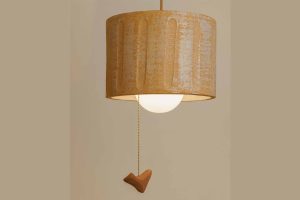
Now in its third residency the Canadian lighting brand has partnered with artist Zeynap Boyan to create ‘The Monumental Collection’. This series of clay fixtures draws inspiration from the legacy of ancient civilisations and the rich cultural heritage of pre-modern Turkey, paying homage to the grandeur of classical architectural while blending elements from Hellenistic, Roman, Byzantine, and Anatolian artifacts into a reimagined, modern lighting design.
When asked about what it was about Boyan’s work and vision that made her fit for this term’s residency, founder of Luminaire Authentik, Maude Rondeau says: “Through this collaboration, Boyan brings her deep understanding of materiality and her poetic approach to form, enriching our creative process. Her hand-sculpted ceramic pieces not only highlight the tactile beauty of clay but also introduce a fresh narrative dimension to our customisable lighting, further pushing the boundaries of what’s possible when art and design come together.”
At the core of every piece by Luminaire Authentik is the harmony between tradition and modernity. Their handmade production process prioritises quality and precision, using a combination of time-honoured craftmanship and innovative designs, where lighting is both sophisticated and functional.
Boyan’s hand-sculpted ceramics presented a unique challenge: integrating delicate, irregular forms with precise lighting systems. The process involved iterative prototyping, testing, and refining to ensure the ceramic components retained their artistic integrity while meeting functional and structural requirements.
Central to each design is a hand-sculpted knob, a defining feature of Boyan’s work that enhances the organic quality of the collection’s forms. Sculpted entirely from stoneware clay, each piece undergoes an oxidation firing process, is finished with hand-brushed glaze strokes, and is completed with Luminaire Authentik’s custom products, showcasing their artisanal approach. Boyan’s choice of stoneware clay and fire oxidation techniques allowed earthy tones and textures to be produced, grounding the collection in naturistic aesthetic while also dedicated to Luminaire Authentik’s sustainable minimum waste practices.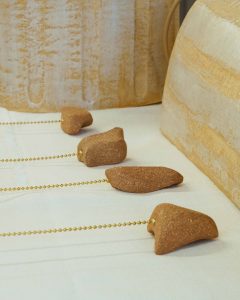
One of the most crucial aspects to get right in the process was addressing the unpredictability of ceramics because factors such as shrinkage can occur during the fire process. Achieving consistent integration with lighting components required balancing the organic imperfections of ceramics with the clean lines of lighting design, this was both a challenge and rewarding creative endeavour.
“Every residency challenges us to think differently about design and innovation,” says Rondeau. “Jeremy Le Chatelier’s [first artist in residency] use of construction waste redefined our approach to materials, while Édith Sévigny-Martel’s [second artist in residency] ceramics introduced new forms and textures to our collections. With Zeynep, the collaboration has pushed us to explore the fusion of tactile, sculptural ceramics with sleek, modern lighting systems, resulting in pieces that are both functional and deeply emotive.”
Boyan’s designs and artistic perspective is profoundly influenced by her time growing up in Istanbul and how remarkable artifacts are seamlessly embedded into everyday surroundings. She recalls how walking through neighbourhoods like Beyoğlu and Sultanahme - where churches, bazaars, mosques, and ancient ruins coexist - felt like stepping into different eras. These experiences offered a tangible sense of existing within a complex, multi-layered environment shaped by countless civilisations.
Boyan adds: “Being surrounded by such a unique blend of history, art, and architecture in daily life can feel both overwhelming and, at times, unnoticed. However, living abroad in recent years has given me a new perspective on how deeply the past informs the present. I now have a deeper appreciation for the complex cultural roots of the places I’ve lived and their ability to hold so many histories at once. The Monumental Collection reflects this personal journey, blending classical forms with contemporary craftsmanship to honour the beauty and strength of this layered heritage, while reinterpreting it in a way that feels fresh and modern.”
The Monumental Collection was released in January with an opening vernissage, followed by a two-day exhibition in Montreal. Luminaire Authentik says they hope the collection will conjure discussions on technical processes and artistic breakthrough among the industry, while evoking the public’s curiosity and wonder to see light as a medium for storytelling and artistic expression.

